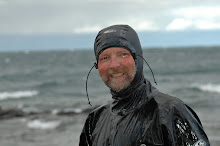 Our annual 'Storm of the Century' was the usual bust. We got about 10' of snow in two separate events and zero wind or drifting. Total snowfall did not even equal half of the 20 plus inches that the breathless weather alarmists in the media were predicting. Thousands of people changed their Christmas plans based upon what the media was trumpeting about this piss ant storm and nothing really happened. My VW Jetta Sportwagon has a ground clearance of about ten millimeters and I never heard the bottom scrape once on snow, other than on the snowplow berm at the end of the driveway. The fact of the matter is that the last time we had a blizzard in the Minneapolis/St Paul area was the Halloween Blizzard of 1991. Duluth had a classic blizzard that pretty much buried Park Point in 2007 and GalwayGuy and I were up there, barely escaping the rampant cannibalism mentioned in the sign below. You can read about the real blizzards of the last 100 years here. One winter threat is real and active now however, and people would do well to be alert. Snow snakes have been spotted over most of the area since the recent snowfall.
Our annual 'Storm of the Century' was the usual bust. We got about 10' of snow in two separate events and zero wind or drifting. Total snowfall did not even equal half of the 20 plus inches that the breathless weather alarmists in the media were predicting. Thousands of people changed their Christmas plans based upon what the media was trumpeting about this piss ant storm and nothing really happened. My VW Jetta Sportwagon has a ground clearance of about ten millimeters and I never heard the bottom scrape once on snow, other than on the snowplow berm at the end of the driveway. The fact of the matter is that the last time we had a blizzard in the Minneapolis/St Paul area was the Halloween Blizzard of 1991. Duluth had a classic blizzard that pretty much buried Park Point in 2007 and GalwayGuy and I were up there, barely escaping the rampant cannibalism mentioned in the sign below. You can read about the real blizzards of the last 100 years here. One winter threat is real and active now however, and people would do well to be alert. Snow snakes have been spotted over most of the area since the recent snowfall. I got my first cross country ski in Sunday afternoon at a local golf course that had been trackset in the aftermath of the 'Storm of the Century'. Due to the wide open fairways and greens that we were skiing over, being attacked by snow snakes was not much of a danger. Last weekend on Reefer Creek though, was a much different story. We spotted snow snakes coiled on a number of trees, ready to strike, and it was only by care and experience that we were able to successfully avoid them. Many can reach 12' to 15' long like the ones in the images.
I got my first cross country ski in Sunday afternoon at a local golf course that had been trackset in the aftermath of the 'Storm of the Century'. Due to the wide open fairways and greens that we were skiing over, being attacked by snow snakes was not much of a danger. Last weekend on Reefer Creek though, was a much different story. We spotted snow snakes coiled on a number of trees, ready to strike, and it was only by care and experience that we were able to successfully avoid them. Many can reach 12' to 15' long like the ones in the images.The beasts can sense your presence from vibration. Any sort of loud noise or concussion will cause them to drop from their perch in the tree, usually on your head. Once you have been struck you need to act fast.You normally feel the concussion on the top of your head and then a cold, wet feeling at the back of your neck. Like certain species of bees, they can only get you once but that's not very comforting once you've been hit. The key to survival is to immediately remove the cold, white venom from your head, down your neck, and down the front of your jacket. If left in contact with your skin, this white substance will morph into a cold, clear liquid which can cause hypothermia if untreated.
 Fortunately, this is a very treatable condition. Quick removal of affected clothing and brushing off the venom is usually all it takes. In more extreme cases where the venom has melted, a prescription of several doses of Bushmills Irish Whiskey can alleviate some of the more aggravating symptoms. The presence of these creatures is no reason to avoid enjoyment of the woods in winter though. Get out there and ski, snowshoe, hike, and have fun. Just be sure to remember to have your first aid kit with a flask of Bushmills tucked into the corner. It's cheap insurance in case you're attacked.
Fortunately, this is a very treatable condition. Quick removal of affected clothing and brushing off the venom is usually all it takes. In more extreme cases where the venom has melted, a prescription of several doses of Bushmills Irish Whiskey can alleviate some of the more aggravating symptoms. The presence of these creatures is no reason to avoid enjoyment of the woods in winter though. Get out there and ski, snowshoe, hike, and have fun. Just be sure to remember to have your first aid kit with a flask of Bushmills tucked into the corner. It's cheap insurance in case you're attacked.


1 comment:
Fantastic Blog, really enjoy
the postings. Corny is a great place and I love alot of snow.
Nothing better then exploring the northland.
Post a Comment